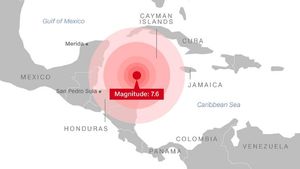A magnitude 7.6 earthquake struck the Caribbean around 18:23 local time on February 9, 2025, sending shockwaves across multiple countries and prompting immediate tsunami warnings. The U.S. Geological Survey (USGS) confirmed the epicenter was located approximately 200 kilometers southwest of George Town, the capital of the Cayman Islands. This earthquake, which had its hypocenter at a depth of 10 kilometers, followed closely on the heels of another minor quake measuring 4.3 magnitude earlier the same day, providing little time for residents to prepare for the larger shock.
The Pacific Tsunami Warning Center wasted no time issuing alerts for areas including Cuba, Jamaica, Mexico, Costa Rica, Haiti, and even extending to include Honduras, Belize, Panama, Nicaragua, Guatemala, and the Bahamas. Residents along coastlines were instructed to evacuate as fear gripped the region. The government of the Cayman Islands took swift action by advising those residing near the coast to move inland, echoing similar sentiments from authorities across the Caribbean.
Residents felt the tremor throughout the islands, eliciting panic and causing many to seek shelter immediately. "We didn't expect such strong shaking at this hour of the night," residents reported. "We quickly moved to higher ground as advised by the authorities," one witness shared. Storm sirens blared as local officials urged calm and emphasized the importance of following evacuation protocols.
Initially, officials feared the potential for catastrophic damage with estimates reaching as high as 8.0 on the Richter scale, which would have posed severe threats to coastal cities. Fortunately, subsequent assessments reassured the public as the magnitude was recalibrated to 7.6, alleviating fears of an apocalyptic event.
Reports indicated significant displacement of families, and emergency services were on high alert, with officials stating, "There are currently no reports of damages or injuries; we will keep monitoring the situation closely." Authorities are closely monitoring coastal waves and the possible arrival of abnormal sea levels following the quake, especially around Cuba and the Cayman Islands.
The aftermath of the earthquake served as a reminder of the region's tectonic volatility; the Caribbean region sits atop the Caribbean tectonic plate, which interfaces with several major plates, including the North American, South American, Nazca, and Cocos plates. This complex tectonic environment makes the region prone to significant seismic activity.
By 1:40 AM Italian time, reports were already indicating the cancellation of tsunami warnings for many territories, but vigilance remained for Cuba, Honduras, the Cayman Islands, Puerto Rico, and the Virgin Islands. "Authorities are asking anyone near southern coastlines to stay alert and heed warnings during this time," local news reported. The USGS emphasized the need for preparedness, stating, "The public should always be ready for aftershocks following such significant earthquakes."
With updates flowing rapidly, residents are urged to stay informed by checking real-time earthquake monitoring websites and following announcements from local authorities. Emergency teams continue settlement assessments, ensuring the safety of impacted communities.
Although the immediate danger of tsunami waves appeared to have diminished, the lasting impact of the earthquake’s tremors carried psychological ramifications as many residents recalled their experiences from past seismic occurrences. "We remain vigilant; these natural events remind us of our vulnerability," shared one local official.
Through community cooperation and governmental response, the Caribbean aims to rise once again, showcasing resilience amid potential crisis. Although the earthquake posed significant risks, proper planning and proactive measures have ensured the safety of many, as the region assesses damage and returns to normalcy.



